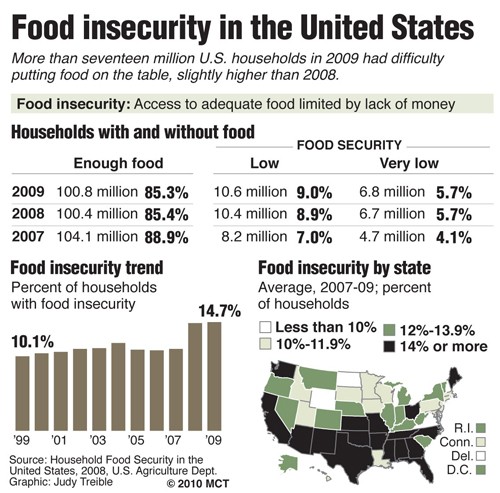WASHINGTON — U.S. agriculture officials said Monday that the nation’s 15 federal nutrition programs helped keep hunger in check in 2009 even as the number of unemployed Americans soared.
After a record one-year increase from 2007 to 2008, the number of U.S. households facing food shortages increased only slightly last year to roughly 17.4 million, according to a new report by the U.S. Department of Agriculture.
The share of households with members who went hungry or cut their food intake because of money also held steady in 2009, albeit at the highest levels since the data were first collected in 1995.
That stabilization in the growth of “”food insecurity”” was the silver lining in the otherwise-bleak report, “”Household Food Security in the United States, 2009.””
The annual survey found that 85.3 percent of U.S. households had enough food for all their members in 2009, about the same share as in 2008.
But more than 50 million Americans — or 16.6 percent — had problems getting adequate nutrition last year. The rates varied widely across states depending on economic conditions.
Arkansas had the highest percentage of food-insecure households, at 17.7 percent. Texas was next, at 17.4 percent, followed by Mississippi, at 17.1 percent. North Dakota had the lowest rate, 6.7 percent, followed by New Hampshire, at nearly 9 percent, and Virginia, at 9.2 percent.
Of the 50 million food-insecure people, 32.5 million lacked money or resources for meals at some point last year, but few of them reported reduced food intake overall.
But the other 17.7 million food-insecure individuals reported multiple instances of inadequate nutrition and disrupted eating patterns because they couldn’t afford meals. These people with “”very low food security”” were up from 17.3 million in 2008. They account for about 6 percent of all Americans.
Kevin Concannon, the undersecretary for food, nutrition and consumer services at the U.S. Department of Agriculture, said the report “”further underscores that household food insecurity remains a serious problem across the United States.””
He credited the nation’s nutritional safety-net programs with keeping millions of adults and youngsters well-nourished during a time of economic crisis. Fifty-seven percent of food-insecure households were enrolled in one or more federal meal programs in 2009, the survey found.
Nationally, the programs “”are indeed doing what they’re intended to do, that is responding to people,”” Concannon said.
This year, an additional 1 million youngsters are receiving free school meals, bringing enrollment to more than 31 million, Concannon said. Also, 400,000 more low-income children and women are enrolled in the Special Supplemental Nutrition Program for Women, Infants and Children.
Enrollment in the Supplemental Nutrition Assistance Program, formerly known as the Food Stamp Program, has grown 58 percent over the last three years and reaches more than 42 million participants. Program benefits were increased last April as part of the economic stimulus bill.
Jim Weill, the president of the Food Research and Action Center, an anti-hunger organization, said the benefit increase was timely and effective.
“”The fact that hunger rates did not skyrocket (in 2009) as they did (in 2008) shows just how effective and essential that increase was and still is,”” he said.
Other findings from the survey of 46,000 U.S. households include:
— The typical household without food insecurity spent one-third more on food than the typical food-insecure home of the same size and composition.
— Food insecurity rates were substantially higher among low-income, single-parent and African-American and Hispanic households.
— Children faced food insecurity in 4.2 million households, about 11 percent of the households with children.
— In the final 30-day period the survey covered, the share of households that reported very low food security fell three-tenths of a percentage point. Improvements were most significant among households with children, black non-Hispanic households and households in the Northeast.









